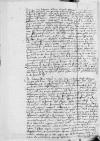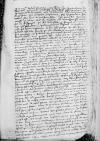Ab eo tempore, quo ad Reverendissimam Dominationem Vestram ex ⌊Vienna⌋ copiose ⌊⌋, quod fuit, nisi fallor, in hac angustia temporis septima aut octava Octobris, binas ab eadem accepi litteras, ⌊⌋ de data XIIII-ae Octobris, quae mihi sunt traditae in ⌊Monsonio Aragonum⌋ XXI Decembris, ⌊⌋, cum ex ⌊Hispaniis⌋ venissem ⌊Pragam⌋, quinta Februarii, quae erant datae ⌊Lubaviae⌋ XI Ianuarii. ⌊⌋ scribit Reverendissima Dominatio Vestra se habuisse ex ⌊reverendissimo domino Lundensi⌋ ⌊⌋, quibus de reditu meo fuerat certior facta, gratulatur, gaudet, et ex animo, uti video, de hoc ipso. Qua in re agnosco tamdiu mihi cognitum expertumque animum ipsius et benevolentiam erga me, de qua alias plura.
Nunc ad rem, quia mihi brevissimum tempus est, iterum enim et crastino die ⌊hinc⌋ abeo ⌊Constantinopolim⌋, natus, ut mihi videor, ad labores, sed quos eo fero libentius, quod sub te doctore eos didicerim, hoc est tuo exemplo fretus nihil existimem esse virtuti invium. Et ita res se habent.
De re mihi commissa de ⌊Isope⌋ et ⌊Ioannica⌋ praesens nihil potui efficere, quia non substiti in ⌊Hispaniis⌋, nisi uno mense, neque fui ⌊Valleoleti⌋, sed solum in ⌊Monson⌋. Sed per ⌊Welzeros⌋ fient omnia et ex parte mea dedi negotium communi amico nostro ⌊Godtscalco Eryco⌋ consiliario caesareo, ut non apud ⌊Ulrichum Ehingher⌋, qui non perinde bene audit, sed apud ⌊Hieronymum Sayler⌋, qui iam ducta ⌊filia⌋ ⌊Bartholomei Welzeri⌋ negotium Welzerorum agit in ⌊Hispaniis⌋ (nam Ulrichus Ehinger, compater tuus, parum verbis temperavit et adversus Welzeros apertam inimicitiam exercet inflatus cruce Iacobea,[1] unde male). Agat, ut cum prima classe mittatur ad domum meam ⌊Brugas⌋ et deinde in ⌊Prussiam⌋, omnino autem puto non fore difficultatem. Ab eo tempore non fui domi, nam redii in ⌊Germaniam⌋ per ⌊Burgundiam⌋, sed ad ⌊coniugem meam⌋ negotium perscripsi ita, ut non sit defectus desuper futurus. Intellexi etiam ex ⌊Nicolao Federman⌋, qui pro ⌊Welzeris⌋ fuit in ⌊Monson⌋, nam ⌊Hieronymum Zayler⌋ non ibi inveni, quod iam recesserat versus ⌊Madritiam⌋, qualiter ille ⌊Welzerorum factor⌋, de quo ⌊⌋ Reverendissima Dominatio Vestra,[2] etiam ad ⌊eum⌋ desuper scripsisset, ita ut non sit futura aliqua difficultas in re, et diligenter ego omnia commendavi. Haec fere sunt ⌊⌋ litterarum contenta. In ⌊⌋ de XI Ianuarii scribit Reverendissima Dominatio Vestra se accepisse ⌊⌋ ex reverendissimo domino ⌊electo archiepiscopo Lundensi⌋, de data XV-ae Novembris. Ex ⌊⌋ intellexisse, qualiter ego manu mea copiose ad eam scripsissem, postquam rediissem ex ⌊Thurcis⌋, id quod verum fuit, nam copiose et prolixe ⌊⌋ eo tempore, hoc est, uti dixi, septima aut octava Octobris. Scripsi ad serenissimam dominam ⌊reginam Poloniae⌋, item ad reverendissimum dominum ⌊Ioannem Choiensky⌋ episcopum Pzremisliensem et ad illustrem dominum ⌊Ioannem comitem in Tarnof⌋. Dedi autem ⌊⌋ ⌊Carolo Kotzer⌋, qui nunc a me interrogatus, qui fiat, ut minime receperit suas Reverendissima Dominatio Vestra, respondet se eas misisse ad ⌊Towrn⌋ oppidum et credere, quod bene sint directae. Aliud non scio, nisi quod forte tales apud vos
sunt, qui non libenter vident aliquid obseratum, quod fortunatum et felix principium non gratulor ⌊Poloniae⌋ vestrae. Aliquamdiu fuit et adhuc est pessimus ille mos apud quasdam gentes, quas novi, quibus ob id ipsum non successit melius. Sed haec alias. In illis ⌊⌋ nihil est scriptum, nisi
cf. Hor. Epist. 1.1.11 quid verum atque decens, curo et rogo et omnis in hoc sum ⌊verum, decenscf. Hor. Epist. 1.1.11 quid verum atque decens, curo et rogo et omnis in hoc sum ⌋
et honestum, cui si quis non favet, cf. Vulg. Dt 28:20 mittet Dominus super te famem et esuriem, et increpationem in omnia opera tua, quae facies, donec conterat te et perdat velociter ⌊perdatur et crepetcf. Vulg. Dt 28:20 mittet Dominus super te famem et esuriem, et increpationem in omnia opera tua, quae facies, donec conterat te et perdat velociter ⌋.
Quod ⌊reverendissimus dominus Lundensis⌋ ⌊⌋ de munificentia erga me serenissimi ⌊Rhomanorum regis⌋, aliquid est tale et verum est. Fuit et erga me ⌊caesar⌋ non minus gratus dato mihi loco et ordine consiliarii secreti apud serenissimam ⌊reginam Mariam⌋ in patria mea. Qui locus est honestus et potero crescere, nam apud nos ⌊rarae sunt sementes ⌋ similium mei,
cf. Curt. 10.2.24, 10.9.6; Liv. 10.2.24; 28.39.11; Tib. 3.19.7 ⌊verbo absit invidiacf. Curt. 10.2.24, 10.9.6; Liv. 10.2.24; 28.39.11; Tib. 3.19.7 ⌋. Habeo gratiam Dominationi Vestrae Reverendissimae, quod me talem videre cupit, qualem amor ipsius erga me esse velit. Equidem semper non abhorrui a mediocritate et in ea nunc sum non magnis neque maximis fortunis praeditus, sed quibus contentus sum, si alia non advenerint. Filium habeo ⌊Cornelium⌋ patris nomine, apud quem et ipsius ⌊matrem⌋ fui quatriduo tantum ⌊Brugis⌋. Sic mihi satis est. Si ex hac peregrinatione mihi contigerit redire, prout omnino spero, dedam me quieti, sic tamen, ut ⌊principibus⌋ meis, patriae et religioni non desim, pro qua utinam honeste hunc spiritum. Tunc frequentius accipies meas, nam haud video, quomodo ante reditum meum ad te scribere possim, animum tamen, cuius corpus et praesentia erit ⌊Constantinopoli⌋, sciat Reverendissima Dominatio Vestra permansurum esse ⌊Lubaviae⌋ et ⌊Brugis⌋, est cf. Hor. Epist. 1.12.13 est animus sine corpore velox ⌊enim celer cursorcf. Hor. Epist. 1.12.13 est animus sine corpore velox ⌋.
De ⌊Ioannica⌋ tua ad ⌊Franciscum Verner⌋ mittenda ⌊Antverpiam⌋ satis in ⌊⌋ scripsi. Fiet, neque de sponsione mea dubitet, quando ea opus non est, cum ⌊Welzeri⌋ ultro ad se susceperint negotium, et non suscipientibus illis ad me semper est refugium, prout praefato magnifico domino ⌊Godtscalco⌋ commisi et ille facturus est.
De ⌊Lubecensibus⌋ vestris et aliis, deque naufragio classis Belgicae non scio, quid dicam, nisi quod haec sunt scripta a ⌊Pompeio Occo⌋ cive Ambsterdamensi ad praefatum ⌊reverendissimum dominum Lundensem⌋, qualiter circa XXII-m Novembris rediit classis ⌊Belgarum⌋ cum navibus praeter armatas fere triginta, quae venerant ex ⌊Gdano⌋ onustae frumento, Hollandicis, quarum navium duae onustae perierunt sub ⌊Norvegia⌋, una autem navis bellica parva sine malis et arboribus fuit dimissa sub Norvegia, nescitur, an perierit. Tres aliae, quae habitae fuere pro perditis, venere ad ⌊Embdem⌋ et sunt salvae. Haec sunt verissima.
De nostris novis Hispanicis haec sunt. ⌊Caesar⌋, ex quo rediit ex ⌊Italia⌋, tamdiu mansit ⌊Barcinone⌋ in ⌊conventu⌋ ⌊Montissonii⌋ cum deputatis trium regnorum: ⌊Aragonum⌋, ⌊Valentiae⌋ et ⌊Cathaloniae⌋, et redigendis in ordinem rebus praefatorum regnorum insumpsit totum illud tempus usque ad paenultimum diem Decembris anni XV-c XXXIII, quo die finis exoptatus impositus fuit illi tractatui. Ex quo ⌊conventu⌋ tria illa ⌊regna⌋, prout moris est illorum, dant libere ⌊caesareae ipsius maiestati⌋ sex centena milia ducatorum dono. Certe ⌊maiestas ipsius⌋ multum laboris insumpsit in componendis negotiis privatorum hominum et materia ⌊inquisitionis⌋, quae non contra hereticos modo et ⌊Iudaeos⌋, et ⌊maranos⌋ coepta fuit institui in praefatis regnis, more regnorum ⌊Castellae⌋, verum etiam contra blasphemantes et iurantes etiam leviter. Voluit et ⌊maiestas sua⌋ malum morem abolere, qui in illis regnis est de denuntiatione belli, quam nobilis ad nobilem facit, hoc est bandelerorum. Utrumque confectum
est ex ⌊maiestatis ipsius⌋ sententia, quae tunc, hoc est paenultima die Decembris, cum mane interfuisset conclusioni praefati ⌊conventus⌋, hoc est Hispanice de las Cortes, abiit, et ultimo die Decembris venit ⌊Caesar Augustam⌋, quo praecesserat ⌊imperatrix⌋, quae est gravida et fert uterum, sana nunc et pulchrior solito.
Ego primo die Ianuarii recessi et inveni ⌊dominum de Nassaw⌋ cum ⌊marchionissa⌋ coniuge sua in ⌊Belpuyts⌋. Qui ⌊dominus de Nassaw⌋ per ⌊Franciam⌋ cum ⌊uxore⌋ venerat habens familiam quadringentorum equorum et amplius inermium, sed optime vestitorum et cum tali pompa, ut omnium ⌊Francorum⌋ iudicio ipse ⌊rex Franciae⌋, qui tunc redibat a conventu ⌊Massiliae⌋, ubi fuit cum ⌊papa⌋, non habuerit tam bene vestitam familiam nec tantum equorum bonorum, vestium, auri, quantum ipse. Quaeris, quid actum sit ⌊Massiliae⌋? Venit ⌊eo⌋ ⌊pontifex⌋, venit et ⌊rex Gallorum⌋, adducta est ⌊neptis⌋ pontificis filia quondam ⌊Laurentii de Medicis⌋, cui datus est titulus ⌊ducatus Urbini⌋, cum ducatum illum teneat ⌊alius⌋. ⌊Ea puella⌋ nupsit ⌊duci Aurelianensi⌋, filio ⌊regis Francorum⌋ secundogenito aetatis 14 aut nondum annorum. ⌊Pontifex⌋, ne aliquando remitteretur haec sua ⌊neptis⌋, prout ab olim ⌊Margarytha Austria⌋ filia ⌊Maximiliani⌋, quae denupserat ⌊Carolo regi⌋, voluit, ut celebraretur matrimonium et exercerentur realiter matrimonialia, ut verbo ⌊Beatricae reginae⌋ utar, auribus autem non credens videre voluit nudum cum nuda et coeuntes in opere – dignum spectaculum ⌊pontifici⌋ et ⌊regi⌋, uterque enim aderat. Complurima feruntur ab ⌊ipsis⌋ tractata, sed publicatum est nihil, nam sine arbitris facta sunt. Certissimum autem est neque id clam est ipsum ⌊pontificem⌋ velle hunc ⌊ducem Aureliani⌋ constituere dominum ⌊Italiae⌋. Principium huius rei erit expulsio ⌊ducis Urbini⌋, veniet enim in ⌊Italiam⌋ ⌊Gallus⌋ per speciem asserendi ea, quae ⌊filio⌋ suo debentur ratione dotis ⌊uxoris⌋. ⌊Cui⌋ praeter praedictum ⌊ducatum⌋ ⌊pontifex⌋ consignabit in manus ⌊Parmam⌋, ⌊Placentiam⌋, ⌊Bononiam⌋, ⌊Anconam⌋ et, si opus est, ⌊Florentiam⌋. Nescio, quid ⌊caesar⌋ ad haec faciet, omnino autem suspecti sunt ⌊caesari⌋ conatus isti neque desunt ⌊Franco⌋ solitae suae practicae ubique et per omnia.
In ⌊Germania⌋ convenere oratores ⌊ligae Suevicae⌋. Est et ibi ⌊iunior dux Wirtenbergensis Christophorus⌋ instans pro reductione in suum ducatum. Nescitur, quid futurum sit.
Nuntio praeterea tibi inventam esse in ⌊Indiis⌋ a caesareanis regionem, ubi tanta est auri copia, quanta est ferri in ⌊Biscaia⌋. Pro probatione huius rei a paucis naviculis, quae eam oram percurrendo forte fortuna incidere in regionem hanc, perlata sunt ad vicesies centena milia castellanorum auri, cuius summae quinta pars ad ⌊caesarem⌋ spectat, reliqua ad eos, qui ibi fuere et sumptus navigationis fecere. Mira de iis et vera tamen dicuntur. Sane Deus mirabilia signa ostendit temporibus nostris. ⌊Caesar⌋ curabit maiore classe eam regionem transcurri. Interim haec praeludia sunt.
In ⌊Hispania⌋ non desii te commendare amicis, quibus cupis. Fama ibi fuerat te mortuum esse, sed excussit eam ⌊⌋ tua prior, quae mihi reddita ⌊ibi⌋ fuit. Itaque omnes te resalutant et ex animo bona omnia illi apprecantur. In ⌊Bohemia⌋ praeter ⌊comitem Nogarolis⌋ optimum virum et tui amantissimum, qui ex animo te salutat, et ⌊Georgium Sapka⌋, ex notis nullus est. ⌊Petrus⌋ tuus apud ⌊Grandvellanum⌋ est, eius ad te ⌊⌋ transmitto.
Quod mihi ⌊Campensem⌋ commendas, gratum est, quod studiis ille intendet. ⌊Eius⌋ ⌊⌋ ⌊Lugduni⌋ impressam una cum nescio ⌊⌋ interpretatione ad te nunc mitto.
Et me precibus tuis apud Deum et memoriae commendatum habe, suscipio enim labores et pericula multa ob rempublicam Christianam nulla alia re inductus, quam intuitu Dei, et quod pulcherrimum existimem de ea bene mereri. Commenda item me dominae ⌊matri tuae⌋, ⌊fratribus⌋, ⌊sororibus⌋ et amicis, et domino doctori ⌊Ioanni Reyneck⌋, cuius causam in absentia mea ⌊reverendissimus dominus Lundensis⌋, qui hic permansurus est, et diligenter, et fideliter nec infructuose aget et expediet, quique se Reverendissimae Dominationi Vestrae ex animo commendat. Et bene valeat eadem Reverendissima Dominatio Tua fausta et felix.



